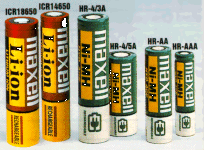

| Lithium High Energy Battery | Lithum Ion Battery |
| by Fraunhofer Institute | by Maxell |

|
 |
The rechargeable Lithium High Energy Battery is based on a totally novel battery system which contains exclusive anorganic components, therefore, the battery cannot explode and the memory effect is reduced.
The battery has a theoretical specific energy of 1070 Wh/kg, which is at the top of the range of all known battery systems. The High-Energy Battery will double the energy content of the known Lithium Ion Battery.
| Theoretical spec. energy Wh/kg | Practical spec. energy Wh/kg | Cell voltage V | |
|---|---|---|---|
| NiCd | 210 | 35 | 1,2 |
| Li/CoO2 | 1070 | 200-300 | 4,1 |
Production of the battery is based upon an innovative technique. A concept for the reutilization of the components is included.
The high power ability of the battery renders the use of an electrolyte solution of high conductivity that is based on a solvate with sulphur dioxide.
The transportation of current inside the battery works via lithium ions. There is no metallic lithium in the system in discharged state. The complete usable lithium stock is intercalated in the positive mass (reversibly stored on interstitial sites of the LiCoO2 lattice).
While charging (cutoff voltage is 4,5 to 4,8 V), lithium ions from the LiCoO2 are deintercalated, and metallic lithium is plated on the current collector of the negative electrode:
| LiCoIII+O2 | ---> | CoIV+O2 + Li+ + e- |
| Li+ + e- | ---> | Li0 |
On discharge (average discharging voltage is 3,9 V; cutoff voltage is 3,0 V), the same reactions take place in the reverse direction:
| CoIV+O2 + Li+ + e- | ---> | LiCoIII+O2 |
| Li0 | ---> | Li+ + e- |